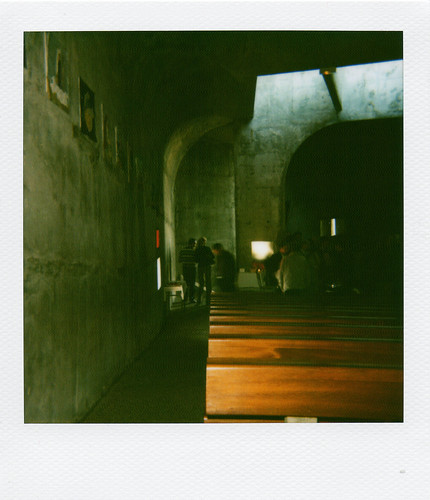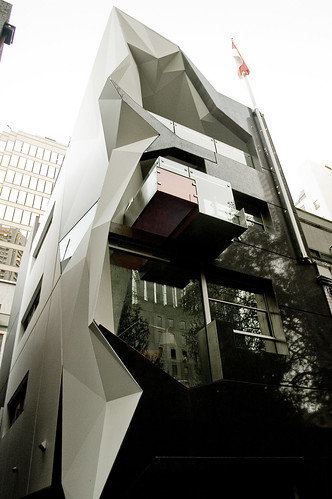
I picked up a few books yesterday afternoon at a
store in Pacific Heights, in the midst of assembling my "Further Reading" list for
The BLDGBLOG Book, and so I've got books on the brain. I thought I'd take a minute or two to stroll through my bookshelves and call out a few of the titles I happen to be reading right now or have recently finished.
So yesterday I bought
Coal: A Human History by Barbara Freese.
Coal tells "the fascinating history of a simple black rock that has shaped our world – and now threatens it." Freese writes, and I quote at great length:
To grasp the magnitude of coal's global impact, we must try to picture history without the momentous, high-intensity pulse of industrialization that started in Britain and then swept the world. The mainly agrarian world would have stayed in place for decades or centuries longer, with slower technological progress, less material wealth, and more gradual social change. Mass-production capitalism would not have soared to prominence, industrial working classes and places like nineteenth-century Manchester would not have mushroomed, and the Communist Manifesto would never have been written. The North might have lost the American Civil War, or it might never have started, and the transformation of the American West would have happened slowly by wagon rather than quickly by rail. The World Wars might never have exploded without the industrial rise of coal-rich Germany. Colonial conquests would have been far less sweeping, dramatically altering the history of all the societies that were dominated by foreign industrial powers, including China's (whose ancient history would have been altered as well). The labor and environmental movements, if they had existed at all, would have taken very different forms. In short, none of the defining and epic struggles of the nineteenth and twentieth centuries would have played out as they did.
It's the intrusion of geology into human history – a kind of economic
batholith – the interaction between a fragment of the earth's surface and the political development of the modern nation.
I also picked up a copy of
The Slave Ship: A Human History – note the identical subtitles – by Marcus Rediker. Here, Rediker looks at the "floating dungeons" of the world's earliest stab at transatlantic globalization:
For more than three centuries, slave ships carried millions of kidnapped Africans across the Atlantic in a "wooden world" where crew and captives alike lived with the ever-present fear of shipwreck, epidemics, and hungry sharks. As a cruel instrument of war and commerce, the slave ship helped to shape the Western world. Yet until now, it has remained a mystery.
Aside from being a social and economic history of the slave ship, the book also explores the ship's technical structure – the mobile architecture of confinement.
I'll hopefully start reading them both soon.
Books I'm currently in the process of reading, or have just finished, and that I'd recommend, include Kitty Hauser's
Bloody Old Britain: O.G.S. Crawford and the Archaeology of Modern Life. Crawford was an aerial archaeologist in England in the early 20th century, his "new skills of interpreting the earth from above," discovering previously unknown landscape details, learned while flying reconnaissance missions during World War I.
Crawford and his colleagues, Hauser writes, "thought prehistory should be approached not through texts (as many archaeologists preferred) not through fetishized 'finds' (like those collected and admired by antiquarians), but through the spatial logic of
geography. It made sense to think about the distribution of particular kinds of objects or sites over geographical space, rather than looking at them in isolation." This was "a way of spatializing prehistory, restoring geographical connections and the materiality of the landscape to a subject that was too often reduced to disjointed objects or texts." After all, she adds, "It was not just where ancient sites were to be found that interested him; it was how they related to each other, what constellations they formed, and how the siting of those constellations related to topography – geology, vegetation, trade routes, sources of water."
 [Images: O.G.S. Crawford and his aerially archaeological airplane; a view of the countryside from above, where remnants of history cast long shadows].
[Images: O.G.S. Crawford and his aerially archaeological airplane; a view of the countryside from above, where remnants of history cast long shadows].Though I haven't finished Hauser's book yet, I'm enjoying it immensely. Hauser also sent me an essay called "Revenants in the Landscape: The Discoveries of Aerial Photography," from her recent book
Shadow Sites. On a casual skim here, that essay appears to deal with the trigonometry of shadows as seen from the air and what these shadows might indicate about unexplored – and abnormal – features in the English landscape. As she writes in
Bloody Old Britain, "at certain times of day, when the sun is low in the sky, the outlines of ancient fields become visible over Salisbury Plain, as shadows throw their ridges and dimples into sharp relief; these are known as 'shadow sites'."
Speaking of Stonehenge, a few months ago I read
Stonehenge, author Rosemary Hill's excellent contribution to the
Wonders of the World series edited by
Mary Beard. While it might seem like the world can't possibly need another book about Stonehenge, Hill's approach is consistently interesting and deliberately written for a general audience. Throughout the book she describes the imaginative, political, artistic, and historiographic influence of the ancient monument, from William Blake's engravings and the architecture of Inigo Jones to the Led Zeppelinized druidry of the late twentieth-century. I read a British copy of the book, published by Profile, but
Harvard University Press – whose
publicity blog is worth a read – has their own version coming out this fall.
For a monument of a different sort, we turn to Glen Canyon Dam. Just last week I finished reading James Lawrence Powell's forthcoming book
Dead Pool: Lake Powell, Global Warming, and the Future of Water in the West. I'd say more about that book here, in fact, but I'm reviewing it for another publication and so I'll save my thoughts for that article. But it is an interesting book, if imperfect, and it presents some very large questions quite early on in the text.
Powell writes:
Why did our government dam nearly every river in the West, some a dozen times or more? Why were dams built even though the associated irrigation projects were obvious money-losers? Why, within a decade or two of the launching of the United States Reclamation Service in 1902, were every one of its founding principles betrayed?
More evocatively, he asks: "What do we do when across the West are spread not beautiful blue-water lakes, but a hundred million acre-feet of mud, some of it laced with toxins? Where then will our successors get their water?"
 [Images: The cover of, and spreads from, Ant Farm: Living Archive 7 by Felicity D. Scott].
[Images: The cover of, and spreads from, Ant Farm: Living Archive 7 by Felicity D. Scott].The idea of speculative futures for otherwise unanticipated monuments brings me to Felicity D. Scott's recent book
Ant Farm: Living Archive 7, published by
ACTAR. Scott's book is a graphically inspired but sluggishly written exploration of Ant Farm, a 1960s/70s American architectural avant-garde, whose projects included mobile educational facilities, "investigations into the psychedelic and environmental potentials of electronic technology," inflatable parachute-buildings and "moment villages" in the American desert, and a bewildering variety of other experimental structures, almost all of which, Scott adds, were "portable, 'instant,' temporary, cheap, and high-tech."
It's
Archigram-meets-
NASCAR amidst inflatable polyethylene megastructures in the California desert – high on LSD and powered by cheap oil – prefiguring today's ongoing experiments in rogue instant-urbanism, like Burning Man.
The book is beautifully designed and it includes an awe-inspiring 120-page
Timeline of the group's output; these images alone – really only about two-thirds of the book's total eye candy – make it a rewarding and memorable resource.
I've been reading a load of other books lately, from Reza Negarestani's future cult-classic
Cyclonopedia to Robert MacFarlane's outstanding
The Wild Places, but I hope to post more about those titles soon.



















 I picked up a few books yesterday afternoon at a
I picked up a few books yesterday afternoon at a  [Images: O.G.S. Crawford and his aerially archaeological airplane; a view of the countryside from above, where remnants of history cast long shadows].
[Images: O.G.S. Crawford and his aerially archaeological airplane; a view of the countryside from above, where remnants of history cast long shadows]. [Images: The cover of, and spreads from,
[Images: The cover of, and spreads from,  I've been following the building of a new hair salon in Australia by Scott Weston over at
I've been following the building of a new hair salon in Australia by Scott Weston over at  The main cutting room.
The main cutting room.  A closeup of the corner chair. The boiserie is printed on paper and mounted to the wall! Even the chairs are stylized! I'm not sure how those curtains will hold up with all the hairspray in the air! I hope they're synthetic!
A closeup of the corner chair. The boiserie is printed on paper and mounted to the wall! Even the chairs are stylized! I'm not sure how those curtains will hold up with all the hairspray in the air! I hope they're synthetic! The table for each stylist is clever as well.
The table for each stylist is clever as well.
 I love details like these painted drawer interiors! Notice: same color as the draperies! It all ties together thoughtfully.
I love details like these painted drawer interiors! Notice: same color as the draperies! It all ties together thoughtfully.





















